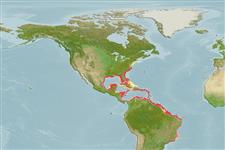>
Carangiformes (Jacks) >
Carangidae (Jacks and pompanos) > Trachinotinae
Etymology: Trachinotus: Greek, trachys, -eia, -ys = rough + Greek,noton = back (Ref. 45335).
More on author: Linnaeus.
Environment: milieu / climate zone / depth range / distribution range
Ökologie
seewasser; brackwasser riff-verbunden; tiefenbereich 0 - 36 m (Ref. 3277), usually 0 - 30 m (Ref. 55175). Subtropical; 42°N - 25°S, 100°W - 30°W (Ref. 55175)
Western Atlantic: Massachusetts, USA to southeastern Brazil, including Bahamas and many of the West Indies (Ref. 7251). Reports from Africa are based on misidentifications, mostly referring to T. teraia (Ref. 81654).
Length at first maturity / Size / Gewicht / Alter
Maturity: Lm 54.7, range 48 - ? cm
Max length : 122 cm FL Männchen/unbestimmt; (Ref. 40637); common length : 94.0 cm FL Männchen/unbestimmt; (Ref. 3277); max. veröff. Gewicht: 36.0 kg (Ref. 5217); max. veröff. Alter: 23 Jahre (Ref. 42149)
Rückenflossenstacheln (insgesamt): 6 - 7; Rückenflossenweichstrahlen (insgesamt): 18-21; Afterflossenstacheln 2-3; Afterflossenweichstrahlen: 16 - 18. Dorsal and anal fins have very long, dark anterior lobes (Ref. 26938). No scutes; a broad patch of orange-yellow on abdomen in front of anal fin; pectoral fins blackish (Ref. 13442).
Adults frequently in channels or holes, over sandy flats, around reefs, and at times over mud bottoms; usually solitary or in small schools; smaller fish tolerate brackish water. Spawn offshore (Ref. 26938). During the summer, juveniles are found in large schools especially in the surf zone along sandy beaches. Adults feed on mollusks, crabs, shrimps, and small fishes; juveniles on benthic invertebrates. Excellent food fish (Ref. 9626). Highly esteemed game fish caught on light tackle (Ref. 26938).
Robins, C.R. and G.C. Ray, 1986. A field guide to Atlantic coast fishes of North America. Houghton Mifflin Company, Boston, U.S.A. 354 p. (Ref. 7251)
IUCN Rote Liste Status (Ref. 130435)
Bedrohung für Menschen
Harmless
Nutzung durch Menschen
Warning: mysqli::__construct(): (HY000/1040): Too many connections in /var/www/html/includes/func_getlabel.php on line 46
Can't connect to MySQL database (fbapp). Errorcode: Too many connections
